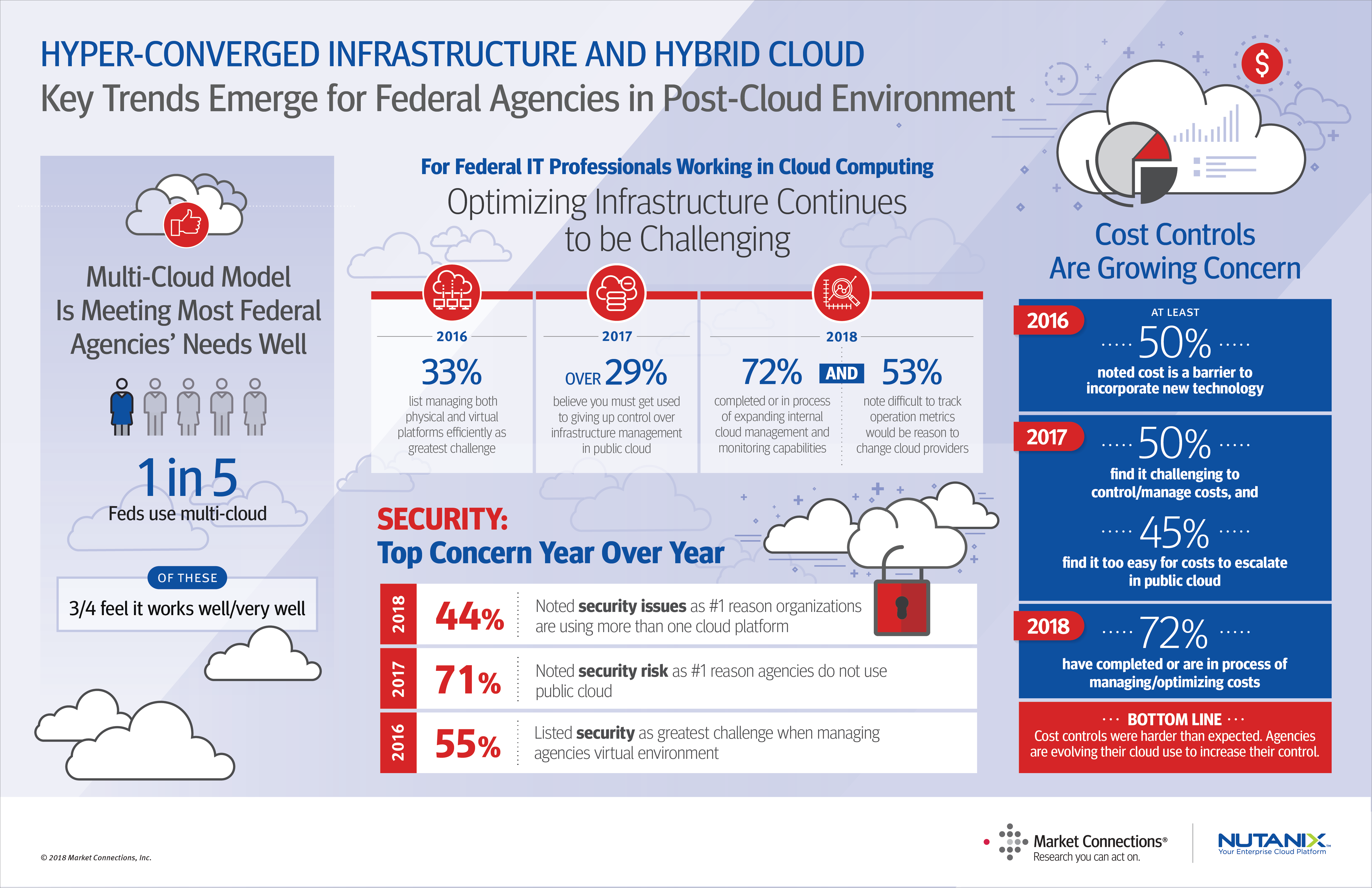
Insight By Nutanix
Hybrid cloud is changing the one-size fits all mindset
A new survey from Nutanix of federal agencies found 20 percent of all respondents are using a multi-cloud approach, and of them,75 percent say it’s working we...
If one thing is true, agencies are excited about hybrid cloud.
Research firm Gartner says in 2017 that 75 percent of all IT managers are using hybrid cloud to meet their needs. And adoption of hybrid cloud has increased by 13 percent year to year while overall cloud adoption overall has increased by 2 percent across the government.
This means there is a huge appetite for a multi cloud approach and it’s only getting bigger.
A new survey from Nutanix of federal agencies found 20 percent of all respondents are using a multi-cloud approach, and of them,75 percent say it’s working well or very well.

Chris Howard, the vice president of public sector for the Nutanix, said the results once again reinforces the fact that one-size doesn’t fit all when it comes to cloud services.
“There has to be different approaches. Everyone has different uses cases. There is an openness to evaluate the best place to run applications and data sets,” Howard said on the IT Innovation Insider program. “As technology has evolved, customers have become more open. I’ve definitely seen a shift. But that doesn’t mean there is a legacy mindset in some agencies, and there isn’t a mindset that there is some one-size-fits-all, which isn’t going to be the case and hopefully the government as time progresses continues to expand their use of the public cloud, on-premise and hybrid cloud technologies.”
Howard said agencies also have evolved how they write solicitations, asking less for specific vendors and just highlighting the need for the flexibility and agility of the cloud.
It was no surprise that security remains the top concern about cloud computing, but 44 percent recognized that using multiple clouds makes them more secure.
Howard said agency security requirements around compliance, data sovereignty and sensitivity levels also are driving the decision to move a multi-cloud approach.
“The workload itself was driving whether they ran it at one cloud or another or kept it on-premise,” he said. “Security drove a lot of the on-premise specific workloads, but now people are looking at security and evaluating a multi-cloud approach. The security requirements the application has are actually dictating which cloud they go with now. That’s a big change from 2016 when it was ‘go to the cloud.’ You could check a box by putting an application in the cloud, but there was less thought around security and the multi-cloud approach.”
Another big driver of the multi-cloud approach is an agency’s desire to better understand and control its costs.
Howard said initially moving to the cloud cost wasn’t a main driving factor, but now five years later, agencies want to optimize costs when putting applications in the cloud.
“You should be able to move whether that’s on a weekly or monthly basis based on where the cost is going to be most beneficial,” he said. “That’s where the multi-cloud approach is really winning out because it enhanced competition, innovation and gives us a better measurement of cost because now we have true competition among these cloud vendors.”
Howard said in 2017 survey 50 percent respondents said cost savings would greater if it would be easier to control and manage costs with the public cloud, while 45 percent of the respondents expressed concern that it was easy for costs to escalate quickly when using a public cloud.
By 2018, Howard said 49 percent of respondents said cloud costs what they thought it would, while 25 percent said the cloud costs more than they expected it would.
At the same time, 72 percent of the respondents are in the process of creating a better management and optimization of their costs in the cloud.
“We feel 25 percent of your applications are best suited for the cloud because they are unpredictable workloads, they scale up real quick and have to scale down,” he said. “But 75 percent of your applications are better suited for on-premise assuming you have an efficient infrastructure. This panacea that the cloud was going to be cheaper than expected, I think, most people realize the cloud is not a cost saver. There are so many more reasons to use the cloud. It’s really how do you optimize it.”
Copyright © 2024 Federal News Network. All rights reserved. This website is not intended for users located within the European Economic Area.
Related Stories

What the UK gets about remote work that the US doesn’t

Postal union calls for Open Season extension after members see enrollment issues
Featured speakers
-

Chris Howard
Vice President, U.S. Public Sector, Nutanix
-

Jason Miller
Executive Editor, FederalNewsRadio.com
Upcoming Events
Related Stories
Top Stories

Chris Howard
Vice President, U.S. Public Sector, Nutanix
Chris Howard is the Vice President of U.S. Public Sector at Nutanix. In this role, he leads a team of more than 100 sales, engineering, channels, marketing, professional services and operations professionals in supporting our U.S. Federal, State and Local government customers, as well as those in higher education. Prior to joining Nutanix, Chris held leadership positions at VMware and Dell. He speaks regularly in various government industry forums, and was a 2016 FedScoop 50 honoree in the Industry Leadership category. He earned his Bachelor of Science degree in Business Administration with a major in Accounting from West Virginia University, and is an avid sports fan.

Jason Miller
Executive Editor, FederalNewsRadio.com
Jason Miller is an executive editor and reporter with Federal News Radio. As executive editor, Jason helps direct the news coverage of the station and works with reporters to ensure a broad range of coverage of federal technology, procurement, finance and human resource news.As a reporter, Jason focuses mainly on technology and procurement issues, including cybersecurity, e-government and acquisition policies and programs.



